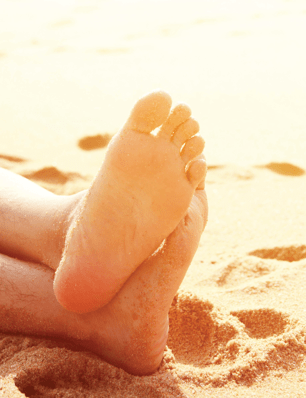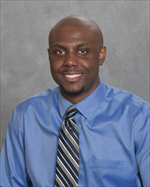Hyperbaric oxygen therapy delivered pure oxygen to a man's organs and connective tissues to promote wound healing.

In the summer of 2020, a Union County man—we'll call him John S.—took a day trip to the Jersey shore. Cautious about sun exposure, he stuck a beach umbrella in the sand. The only parts of his body not covered were his feet.
John had uncontrolled diabetes, which in turn had led to neuropathy—a form of nerve damage that can cause a patient to be unable to feel pain. He didn’t notice until he got home that both of his feet, but especially the right one, were badly sunburned.
Eventually, blisters formed on the burned areas. Because of his neuropathy, he wasn’t in pain, but he could see that the blisters had popped and formed scabs. He went to an urgent care center and was given an antibiotic burn cream, but the wound did not improve.
Recognizing that the problem was serious, he made an appointment at the Center for Wound Healing and Hyperbaric Medicine at Robert Wood Johnson University Hospital (RWJUH) Rahway. There, he met with Chudi Mgbako, DPM, Chair of the Foot and Ankle Surgery Division at RWJUH Rahway.

“When I first evaluated this patient, he had a third-degree burn on the top of his right foot, which went all the way down to his bone,” Dr. Mgbako recalls. “I then took a bone biopsy that was positive for osteomyelitis, which is a bone infection.”
Advanced Treatments
Diabetic neuropathy affects about half of people with diabetes. Over time, high levels of blood sugar (glucose) cause damage to the nerves, most often in the legs and feet. Although diabetic neuropathy can sometimes be painful, it can also lead to numbness.
John had to see Dr. Mgbako weekly for wound care treatment, which included draining pus and the use of wound VAC (vacuum-assisted closure) therapy to decrease the air pressure on the wound and support healing. He was also given antibiotics intravenously. In spite of this care, he twice developed an abscess in his foot.
Because the aggressive infection was not progressively healing with standard wound care treatment, Dr. Mgbako and his wound care team decided that hyperbaric oxygen therapy should be the next step.
With hyperbaric oxygen therapy, the patient breathes pure oxygen while inside a pressurized chamber. This mechanism of oxygen delivery helps blood carry more oxygen to organs and connective tissues to promote wound healing. At the same time, the oxygen increases the ability of white blood cells to fight infection.
Each session takes two hours; a TV is provided to help pass the time. About 30 sessions were needed over the course of six weeks. By the end of February 2021, the foot had healed.
The whole experience changed John’s attitude toward his health. He now eats a diabetes-friendly diet, not only avoiding sugar but eating lots of fruits, vegetables and healthy grains. Because exercise helps control blood glucose levels, he takes the stairs rather than the elevator when he’s at work and has become more physically active in other ways as well. Just as important, he pays attention to the condition of his feet and doesn’t go barefoot or expose his feet to the sun without adequate protection.
Dr. Mgbako advises patients who have diabetes to check their feet daily for wounds. “Patients shouldn’t simply trust their sense of touch, which is often compromised from neuropathy,” Dr. Mgbako says. “If they see any suspicious wounds on their feet, they should contact their doctor right away. This simple step could literally prevent worsening infections and amputations.”
Wound Warnings for People with DiabetesPeople with a chronic illness such as diabetes or diabetic neuropathy need to pay regular attention to their feet and skin. The time spent on this care can be rewarded with better health outcomes and less time spent dealing with more severe issues.
|
To learn more about the Center for Wound Healing and Hyperbaric Medicine, call 732-453-2915. For help managing diabetes with an RWJUH Rahway outpatient dietitian, call 732-499-6210.